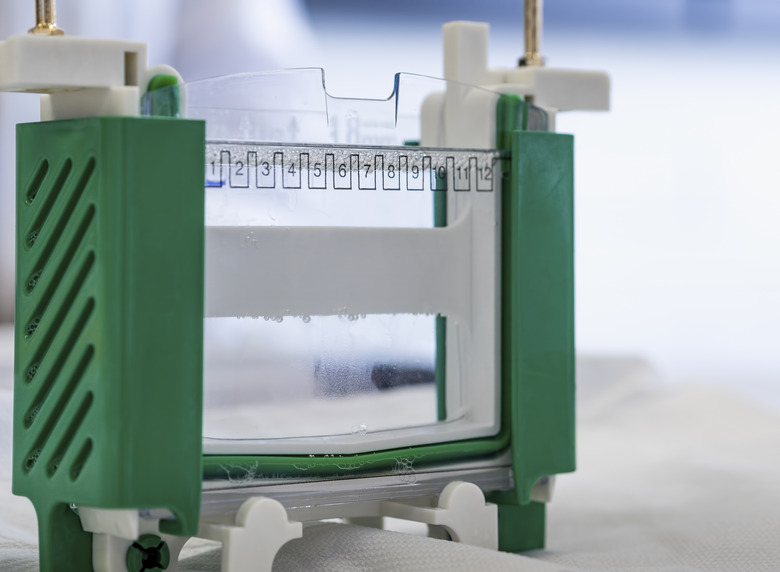The Purpose Of The Buffer In Electrophoresis
Biochemists and molecular biologists use electrophoresis to separate macromolecules like proteins and nucleic acids. This allows scientists to isolate and analyze individual proteins or nucleic acid sequences in a complex mixture. A typical example of electrophoresis in the lab is a microbiologist using Polymerase Chain Reaction (PCR) to separate DNA fragments produced in a microbial community. Regardless of the purpose, electrophoresis always requires the use of a buffer solution.
TL;DR (Too Long; Didn't Read)
Electrophoresis separates macromolecules like protein and nucleic acids by size, charge and other properties. For electrophoresis that separates by charge, scientists use buffer to transmit that charge through the gel. Buffer also maintains the gel at a stable pH, minimizing changes that could occur in the protein or nucleic acid if subjected to unstable pH.
Principles of Electrophoresis
Principles of Electrophoresis
Electrophoresis separates molecules along a gradient based on their size, charge or other properties. That gradient can be an electrical field or, in the case of Denaturing Gradient Gel Electrophoresis (DGGE), a denaturant such as a mixture of urea and formamide. Proteins will migrate toward the anode if negatively charged and the cathode if positively charged. Since larger molecules migrate more slowly than smaller molecules, scientists can measure the distance traveled and use logarithms to determine the size of the fragments.
Denaturing Gradient Gel Electrophoresis
Denaturing Gradient Gel Electrophoresis
With DGGE, DNA moves along a gradient of increasing denaturing power until the power is sufficient to denature, or unfold, that particular DNA fragment entirely. At this point, the migration stops. Scientists can use this method to separate fragments based on their individual susceptibility to denaturing.
What the Buffer Does
What the Buffer Does
In the case of electrophoresis that separates on the basis of charge, ions in the buffer transmit the charge necessary for separation. The buffer, by providing a reservoir of weak acid and base, also keeps the pH within a narrow range. This is important because the structure and charge of a protein or nucleic acid will change if subjected to significant pH changes, thus preventing proper separation.
Typical Buffers
Typical Buffers
Different buffers are ideal for maintaining the electrophoresis gel at different desired pH ranges. Typical buffers used by scientists for this purpose include acetic acid, boric acid, phosphoric acid and citric acid as well as glycine and taurine. Generally, the pKa value (acid dissociation constant) should be close to the required pH. It is preferable to us buffers that provide a low charge magnitude so as not to conduct too much current.
Cite This Article
MLA
Collins, Pete. "The Purpose Of The Buffer In Electrophoresis" sciencing.com, https://www.sciencing.com/purpose-buffer-electrophoresis-6613320/. 21 May 2018.
APA
Collins, Pete. (2018, May 21). The Purpose Of The Buffer In Electrophoresis. sciencing.com. Retrieved from https://www.sciencing.com/purpose-buffer-electrophoresis-6613320/
Chicago
Collins, Pete. The Purpose Of The Buffer In Electrophoresis last modified August 30, 2022. https://www.sciencing.com/purpose-buffer-electrophoresis-6613320/
